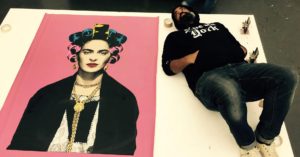Artist M. Tony Peralta never intended for his brand to become a Latino lifestyle statement. But when a him lying next to his canvas of a Frida Kahlo in hair rollers got overwhelmingly positive feedback on Instagram, he knew he was onto something.
“I started to notice there’s something there, because there’s really nothing out there that speaks to Latinos,” he said.
Four years after first opening his Instagram account, Peralta has developed an exceptional following, with more than 20,400 fans, many of whom are Dominican and more than 60 percent of whom are female.
“I’m carving my own niche and I’m making my own lane,” the artist-turned-entrepreneur tells CNBC.
Opting for self-employment over a traditional 9-to-5 as Peralta did is not new, but it has been on the rise among people of color. According to The Kauffman Foundation’s 2016 start-up index, while new business creation is recovering from a 40-year-low, the share of Latinos becoming entrepreneurs has risen 10.8 percent since 1996. Asians make up 2.3 percent more entrepreneurs than they used to. African-Americans also experienced an increase, though a smaller one: only .05 percent.
Among minorities, social media is also on the rise. A 2015 Pew Research Center report shows 47 percent of African Americans and 38 percent of Hispanics are on Instagram. On Facebook, those numbers rise to 67 and 75 percent, respectively.
With an increased presence on both platforms, several Hispanic and black entrepreneurs have decided to use social media for a purpose: to expand and engage with their core audience.
Peralta started his business to enter the street-wear scene. Initially, he sold shirts with hyper-local nods to his neighborhood, Washington Heights. At pop-up shops his shirts became popular, but he made barely enough money to break even.
When he used Instagram to branch out, new customers across the country started buying his merchandise, including people originally from New York City and Latinos.
After getting a break with his Frida Kahlo design, he started using the platform as a barometer to decide what pursue as apparel designs and helped shape his store. That’s become a fruitful strategy.
“I Photoshop, I create and if people like it I’ll go ahead and [turn it into a clothing piece],” he says. “Otherwise it’s just an Instagram post.”
Today, some of his most popular designs highlight common Latino household items, like a can of black beans or popular Cuban coffee, Cafe Bustelo.
While Peralta found a niche audience on social media organically, some entrepreneurs turn to the app for deliberate, practical reasons. Jonathan White, for example, found that sending text blasts to thousands of contacts was not a sustainable way to advertise his merchandise.
“At the time you could only send a text to a maximum 20 people at a time,” the entrepreneur said. “I was sending out blasts all day long.”
He had just launched his clothing apparel company, Cashland, and plenty of people knew about the business through word-of-mouth and his work in community education. But to expand his audience, he knew he had to use social media.
“I’M CARVING MY OWN NICHE AND I’M MAKING MY OWN LANE.”
First, it was MySpace. Next it was Facebook. Most recently, the company has shifted attention to Instagram.
And the engagement paid off. Cashland, which only has brick-and-mortar locations in Baltimore, now has fans all over the map.
The account has more than 52,600 followers. White says Instagram helps him run all business aspects of the company, including selling merchandise. And the founder, who goes by the stage name “Jon Cash,” has developed a considerable audience himself of 17,400 followers.
Through all these accounts, he’s resonated with a core audience: African-American millennials.
The founder credits some of his success at reaching customers on social media to connections made with local and national rapping artists. Cashland makes conscious efforts to push its merchandise, and it has gotten the brand airtime on Snoop Dogg’s and Wiz Khalifa’s popular Instagram accounts.
While both Peralta and White appreciate that their content now reaches an audience that it means a lot to, they also happy sharing it with anyone who enjoys their work.
“This is what’s working for me. I make art for a group of people who are underrepresented,” Peralta said, adding, “I’ll engage with anyone.”




Recent Comments